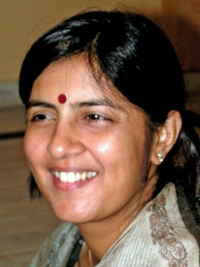Vow Nine:
I will not encourage socially evil customs.
The ninth vow is difficult to categorize, in that "socially evil" can refer to behavior contrary to any of the Anuvrat: ahimsa, satya, asteya, aparigraha or brahmacharya. Instead, I interpret this vow to be an attempt by Tulsi to focus attention more on the potential harmfulness of "customs" and tradition. Acharya Tulsi felt a strong need for changing some of the customs and traditions prevailing in the Indian society. He viewed customs like purdah (the practice of covering women's faces and limiting their access to public space); dowry (the requirement that families pay money to the grooms family upon the marriage of their daughters) which can lead to the practice of female feticide if the family feels a daughter would be too much of an economic burden; and the practice of forbidding remarriage and limiting other rights of women who have been widowed, as obstacles to a developing society. Hence, he introduced many reforms through his movement such as: simplifying birth, death and marriage ceremonies; encouraging women's literacy, and removing purdah are among a few from the list. Tradition may have a valid role to play in formulating social identity, but Tulsi encouraged his followers to examine customs, increase their awareness of the potential harm, and to be open to adjusting harmful customs when necessary.
Many of the reforms initiated by Tulsi lean towards women's rights. Perhaps it is inter-connected with the fact that many of the female respondents were conjured to express their deepest reverence to the founder. Sometimes I asked them did the then leaders of India not facilitate similar changes also. Out of many, an impactful reply that I received was: "Acharya Tulsi was certainly not the only one to introduce social reforms, but he definitely was one of the first to address them among the masses."[103]Apparently such a statement derives from a personal admiration for the Guru.
My respondents reported that these reformative changes had significant impact first within the mainstream of the Terapanth sect and gradually grew elsewhere. However, it is hard to claim that the movement has achieved its goal of eradicating social evils from Indian society. For example, within the more educated, economically higher strata of the population, dowry may not be promoted as openly but it is still a subtle method of exchanging commodities and among the less educated communities, dowry is still viewed as an economic burden for families with female children and a potential source of economic opportunity for families with male children. Nevertheless, the examples set by those people who have chosen not to follow traditions like purdah, dowry and female feticide have been leading to a slow but steady overall shift in society's attitudes towards these practices and a growing recognition of their potential harmful effects.
 Shivani Bothra
Shivani Bothra
